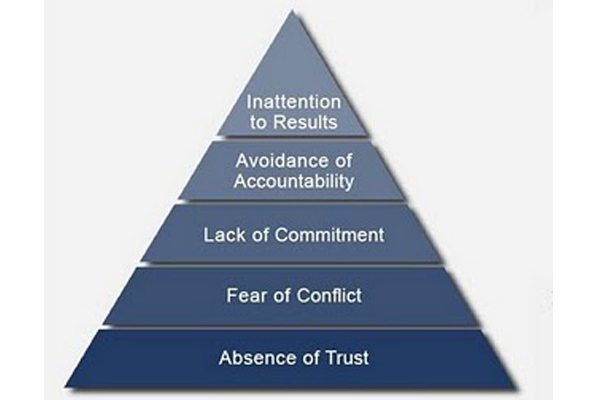 We recently worked with a senior team which had a new leader. The fact that the leaders working style was very different from the previous leader and the added fact that nearly half of the members were new to the team, made it necessary for the team to get into an offsite – to try and construct a cohesive team identity.
We recently worked with a senior team which had a new leader. The fact that the leaders working style was very different from the previous leader and the added fact that nearly half of the members were new to the team, made it necessary for the team to get into an offsite – to try and construct a cohesive team identity.
Constructing an identity for a team – is never something that happens overnight or in a two day workshop. It is always the result of the members of the team making a deliberate effort and showing deliberate intent in making it work.
Seen through the lens of a theoretical construct like Bruce Tuckmans team building model, it is always a journey – from Forming to Storming to Norming to Performing. And like every journey has its highs and lows, so does this journey. Its definitely not easy – which is why there are so few great teams – but if the members of a team show sufficient resolve to grit it out and work through the tough phases – the reward of being a part of a high performing team can be very satisfying.
Seen in another way, making a team into a high performing one is very much akin to the ingredients that go into a successful and happy marriage. Not always hunky dory – but where the partners have shown sufficient patience and belief, in trying to work through the differences.
If you leading a team and are trying to mould it into a cohesive unit, here are a few things that you need to keep sight of:
1) Role & Expectation clarity
Each person in a corporate team generally carries a designation that denotes his area of responsibility. However, the scope of the work within that area – and the expectations that different team members have of each other, can vary vastly as per individual interpretations. Having proactive one-on-one interactions to clarify and sign-off on expectations is a major step towards team alignment. Many a marriage has been saved by such simple sign-offs and understanding: I do the dishes – you take care of the baby.
2) Rules of Engagement
In many teams we see – the intentions are always noble. For example: saying – we will respect each others time – is a noble thought. However, if this is not converted into actionable behaviors that someone can track, it unfortunately remains just that – only a noble intention. Soon, when the pressure of day to day business catches on, these niceties are often forgotten. Hence – it is very important to convert an intent into actionable and trackable behaviors. Hence the intent described above can be broken down into a few behaviors:
- We shall ensure that all meetings start and end on time
- We shall not schedule meetings on holidays or next to holidays
- We shall not send an email on a weekend and expect an immediate reply
Intent – to be effective in a team context – needs to be converted into rules of engagement that every member of the team signs in to.
3) Knowing each other better
It is called the fundamental attribution error. “If I make an error – it’s a mistake. If you make an error – its bad intent.” The one way to get over this as a team is to know each other better in a deeper meaningful sort of way. If I know where you come from, your personal history, your deepest values and influences, your challenges and fears, your hopes for the future – there is a much better chance that I will trust you as an individual. The more I know you – the better I trust you.
Teams at times find such sharing very difficult – and “touchy-feely”. The use of a skilled Facilitator at such times can often help smoothen the conversations. Another good way to do this is by using psychometric tools like the Myers-Brigg Type Indicator, aided by a certified professional.
4) Shared Aspiration & Pride
Very often what brings teams very close to each other is a shared but over-arching goal that everyone wants to achieve together as a team. Many such stories are today the stuff of legends that come alive in our movies like Lagaan, Apollo 13, Chak De & many more.
What is true in these movies is equally true for every other team too – regardless of whether it’s a sports team or a corporate team or even a family. Hence, it is very important for a leader to tap into the shared aspirations of his team and define as clearly as possible, what is the shared aspiration of the team as a whole. Leaders in particular should be particularly wary not to impose solely their thoughts on their constituents, because finally what people don’t buy-in to, they will not commit to.
One final point on this is – for the leader to ensure that what gets finally defined as a shared aspiration or goal for the team is something that will evoke pride in its members on successful achievement. Other than being S.M.A.R.T, the goal needs to inspire.
5) Shared memories & Team stories
Think about it – when someone asks you about your best moments in a relationship, what do you recall? It is always the memory of a holiday well spent, an adventure jointly taken or something achieved together as a team.
But memories and team stories do not happen by accident. It happens by showing intent. So that offsite that you are planning for your team is not just a distraction, it is a meaningful investment in trying to get your team closer together. Investing in conducting an engaging and fun intervention for your team at such offsites is again not a luxury – but a necessity, if you consider team cohesiveness as an essential ingredient to market success.
6) Symbols, Names, Logos
It is not just an accident that all very cohesive teams in organizations – like the armed forces, sports teams, hospitals and even some corporates – wear an uniform.
As Seth Godin, argues in his book Tribes – human beings have a need to belong, “to be part of a tribe”. Symbols, team names and logos help give teams a tangible identity to which they “belong”. A few other ideas that can easily be actioned by leaders trying to create a tangible team identity is to come out with a team mascot, team color, team slogan, team song, team cheer, team rituals, team newsletter, team T-shirt or even a team greeting.
It is not easy. It takes conscious and relentless effort – but if a team is intent on becoming more cohesive and aligned, I guess it will take the effort to make it work. As I said, it is like a marriage – if you think it is worth it, you will put in all the efforts to make it exciting, alive and meaningful for both of you.
Is your team taking this journey too? Do share your experiences.










